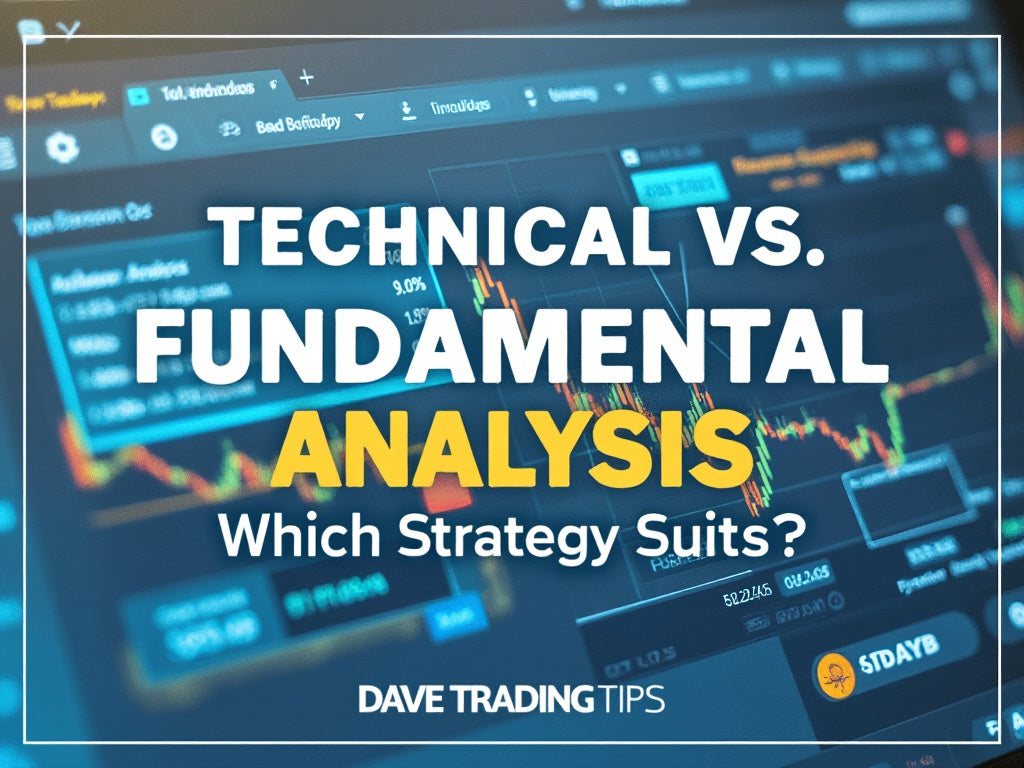
Technical vs. Fundamental Analysis: Which Strategy Suits You?
Introduction
When it comes to trading, there are countless strategies out there, each with its unique appeal and potential for profit. But how do you know which one is right for you? The choice between technical and fundamental analysis is one of the most significant decisions you'll face as a trader. Whether you're new to trading or looking to refine your approach, understanding these two strategies is crucial for your success.
Technical analysis and fundamental analysis represent two very different schools of thought in the trading world. One focuses on price movements and market trends, while the other delves into the underlying financial health and intrinsic value of an asset. But which one should you rely on? Let’s dive into both strategies to help you decide.
Understanding Technical Analysis
Technical analysis is all about studying price charts, patterns, and market trends. Traders who use this approach believe that all the information they need is already reflected in the price movements of an asset. By analyzing these movements, they aim to predict future price behavior.
Core principles of technical analysis include the belief that prices move in trends, history repeats itself, and market action discounts everything. Traders use various tools and indicators, such as moving averages, Bollinger Bands, and Relative Strength Index (RSI), to identify trading opportunities. These tools help traders spot potential entry and exit points, making technical analysis particularly popular among short-term traders and day traders.
Understanding Fundamental Analysis
On the flip side, fundamental analysis digs deeper into the financial health and performance of a company or asset. This strategy is about understanding the intrinsic value of an asset by analyzing economic indicators, financial statements, and industry trends.
Core principles of fundamental analysis involve evaluating a company's revenue, earnings, future growth prospects, profit margins, and overall industry health. Investors using this approach aim to determine whether an asset is undervalued or overvalued compared to its current market price. Key metrics like the price-to-earnings (P/E) ratio, earnings per share (EPS), and debt-to-equity ratio are often used to make informed decisions.
Technical Analysis: Pros and Cons
Advantages of technical analysis include its ability to provide quick insights into market trends and identify short-term trading opportunities. It’s highly versatile, applicable to any asset class, and doesn’t require a deep understanding of the asset’s underlying fundamentals. This makes it ideal for traders who prefer to react swiftly to market movements.
However, the disadvantages are also notable. Technical analysis can sometimes lead to false signals, especially in volatile markets. It also requires a significant amount of discipline and the ability to interpret charts accurately, which can be challenging for beginners.
Fundamental Analysis: Pros and Cons
Advantages of fundamental analysis lie in its long-term perspective. By focusing on a company's financial health and market position, this approach helps traders make informed decisions that are less susceptible to market noise. It’s particularly useful for identifying long-term investment opportunities and understanding the broader economic environment.
On the downside, fundamental analysis is time-consuming and requires a deep understanding of financial statements and economic indicators. It might not be as effective for short-term trading since market prices can deviate significantly from an asset's intrinsic value in the short term.
Comparison: Technical vs. Fundamental Analysis
When comparing the two strategies, the key differences lie in their focus and application. Technical analysis is centered on market data and price action, making it more suitable for short-term trading. Fundamental analysis, however, is based on economic data and financial performance, making it better for long-term investment decisions.
The impact on decision-making also varies. Technical traders might make multiple trades in a day based on chart patterns, while fundamental traders might hold positions for months or even years, waiting for the market to recognize the true value of their investment.

When to Use Technical Analysis
Technical analysis is most effective in highly liquid markets with significant trading volume, such as forex, stocks, and commodities. It’s particularly useful during times of high market volatility, where quick decisions are necessary to capitalize on price movements.
For example, a day trader might use technical analysis to identify a breakout pattern in a stock chart, allowing them to enter a position just as the stock begins to rise. This approach can be highly profitable when applied correctly, but it requires constant attention and quick decision-making.
When to Use Fundamental Analysis
Fundamental analysis is best suited for long-term investors who are more interested in the underlying value of an asset than its short-term price fluctuations. This approach is particularly effective in markets where assets are frequently mispriced due to short-term market conditions.
For instance, an investor might use fundamental analysis to identify a tech company with strong earnings growth and a competitive edge in its industry. By investing in this company early, the investor can potentially reap significant rewards as the market eventually recognizes the company's true value.
Can You Combine Both?
Interestingly, many successful traders combine both technical and fundamental analysis to form a more comprehensive trading strategy. This hybrid approach allows traders to benefit from the strengths of both methods while mitigating their weaknesses.
For example, a trader might use fundamental analysis to identify a company with strong growth potential and then use technical analysis to time their entry into the market. This combination can help traders maximize their profits while minimizing risk.
Which Strategy Suits You?
Choosing between technical and fundamental analysis ultimately comes down to your trading style and personal preferences. If you enjoy analyzing charts and making quick decisions, technical analysis might be for you. On the other hand, if you prefer to dig deep into financial reports and take a long-term view, fundamental analysis could be a better fit.
Before deciding, ask yourself these questions:
Do you prefer short-term or long-term trading?
How much time can you dedicate to research and analysis?
What is your tolerance for risk?
These factors will play a crucial role in determining which strategy is best for you.
The Role of Time Horizon
Your time horizon is another critical factor to consider. Short-term traders who hold positions for a few hours or days may find technical analysis more beneficial due to its focus on immediate price movements. Long-term investors, who hold assets for years, might prefer fundamental analysis, which is more aligned with assessing long-term value.
Risk Tolerance and Strategy Selection
Risk tolerance is closely linked to the choice between technical and fundamental analysis. Technical analysis often involves higher-risk, high-reward scenarios, while fundamental analysis tends to be more conservative, focusing on long-term growth and stability.
To gauge your risk tolerance, consider how you react to market volatility. If you’re comfortable with the possibility of quick gains and losses, technical analysis might suit you. If you prefer steady growth and are more risk-averse, fundamental analysis could be the way to go.
Learning and Mastery: Building Expertise in Your Chosen Strategy
Regardless of the strategy you choose, continuous learning is essential. For technical analysis, resources like charting courses and trading simulators can help you hone your skills. Fundamental analysis enthusiasts might benefit from studying financial accounting, economics, and industry reports.
Mastery takes time, but with dedication, you can develop the expertise needed to succeed in your chosen strategy.
Common Mistakes to Avoid
Both strategies come with their own set of pitfalls. In technical analysis, common mistakes include overtrading, ignoring broader market trends, and relying too heavily on a single indicator. In fundamental analysis, traders might make the error of underestimating market sentiment or failing to account for macroeconomic factors.
To avoid these mistakes, it's important to maintain a balanced approach, diversify your analysis, and remain open to learning from each trade.
Conclusion
In the end, the choice between technical and fundamental analysis isn’t about finding the “right” strategy—it's about finding the right strategy for you. Both approaches have their strengths and weaknesses, and your success will depend on how well you can align your strategy with your trading style, risk tolerance, and time horizon.
Experiment with both, learn from your experiences, and over time, you'll discover the approach that works best for your unique trading journey.
FAQs
1. Can beginners use both technical and fundamental analysis?
Yes, beginners can use both, but it’s advisable to start with one and gradually integrate the other as they gain more experience.
2. How long does it take to become proficient in either strategy?
It varies, but with consistent practice and study, most traders can gain a solid understanding of either strategy within 6 months to a year.
3. Is one strategy more profitable than the other?
Profitability depends on the trader’s skill and the market conditions. Neither strategy is inherently more profitable; it’s about how well you apply them.
4. Can fundamental analysis be useful for day trading?
While less common, fundamental analysis can be used for day trading, especially when trading on news or earnings reports.
5. What are the best tools for technical analysis?
Some popular tools include Moving Averages, RSI, MACD, and Bollinger Bands. Trading platforms like MetaTrader and TradingView offer these tools.


Leave a comment
This site is protected by hCaptcha and the hCaptcha Privacy Policy and Terms of Service apply.